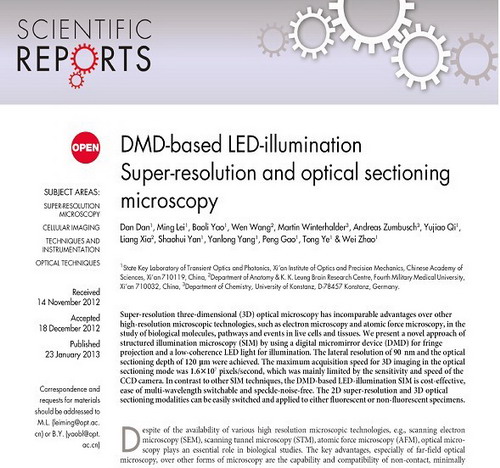The latest Scientific Reports, supplement of Nature, published on Jan. 23, 2013 published the research paper which is contributed by research team led by Researcher Yao Baoli with State Key Laboratory of Transient Optics and Photonics, XIOPM and titled “DMD-based LED-illumination Super-resolution and optical sectioning microscopy”. It’s the first time that XIOPM published paper on the Nature series.

It is well known that optical imaging technology plays an important role in human’s discovering and exploring into the secret of the unknown. People pursue to seeing further, more thorough and clearer, no matter the large universe or even small molecule. However, limited to diffraction of light, the spatial resolution in traditional optical system is not possible to be infinitesimal due to the Rayleigh-Abbe physical limit. Therefore, it is acknowledged in current optical field to be a major research subject to break this limit and improve the existing imaging resolution of optical system.
Obviously, there are technologies like electron microscope and atomic force microscope which may get higher resolution, but due to various reasons and limitations (for instance, intravital time imaging is unavailable and sample preparation is complex), optical microscope is the main observation apparatus in present biomedical research field, material chemistry research field and etc. The lateral resolution of general optical microscope is limited to about 200nm, which is not precise enough for research of subcellular structure and molecular biology. In order to break the diffraction limit, many optical super-resolution methods are sprang out in recent years, including PLAM, STORM, STED and etc. However, all these method are limited to unimolecule location algorithm or spot scanning imaging which have a relatively lower speed and need some special dyestuff to mark samples. Besides, SIM is another method. It uses specially modulated light field illumination sample and obtains super-resolution image though spatial spectrum processing. Since it belongs to wide field imaging method, it forms images fast. Presently, only America, Germany, Britain, Switzerland, Japan and other several states could control SIM technology and China relatively lags behind in this field.
Research team leader Yao Baoli with XIOPM has been long engaged in research on bio-photon technology like optical micro-manipulation technology and optical super-resolution imaging (optical tweezer has been applied into production). Since the development of SIM imaging technology in 2010, supported by major scientific research program, Ministry of Science and Technology of the People’s Republic of China and national natural science foundation program, deep and thorough theoretical and practical researches have been conducted, key technologies concerned have been mastered, an innovative plan different from existing laser interference illumination SIM technology (which has been applied for national invention patent) was presented and SIM technology based on DMD and LED illumination was proposed firstly and realized. Compared with laser interference illumination SIM technology, this technology has higher spatial resolution, faster imaging speed and images with better quality and it greatly reduced the device’s complexity and cost. Through calibration, the system’s lateral resolution reaches 90nm which is the best in the same field over the world. To prove the technology and the practical application effect of the model machine in biochemical field, the research team and The Fourth Medical University cooperated with University of Konstanz to conduct experiment research. Using this system, they successfully got super-resolution images of mitochondria of BPAE and cerebral neuron of mouse and realized 3D optical sectioning of mouse’s cerebral neuron and plant pollen. Compared with current sectioning microtechnic, it is about ten times better in imaging depth and speed, which provides a new technology for forming large-area and fast 3D images to underlying biological samples.
Super-resolution imaging technology is an important research direction both in present international optical field and 135 plan of XIOPM. The research result edged XIOPM into the world front rank in the field of super-resolution optical microscope. Crossing and cooperating with biomedicine and material chemistry, the technology would greatly improve China’s research level in the field and its achievement transformation would change the situation that China has no high-tech device with independence intelligent property right in the field of super-resolution optical microscope.
Article link address (free download):
http://www.nature.com/srep/2013/130123/srep01116/full/srep01116.html


